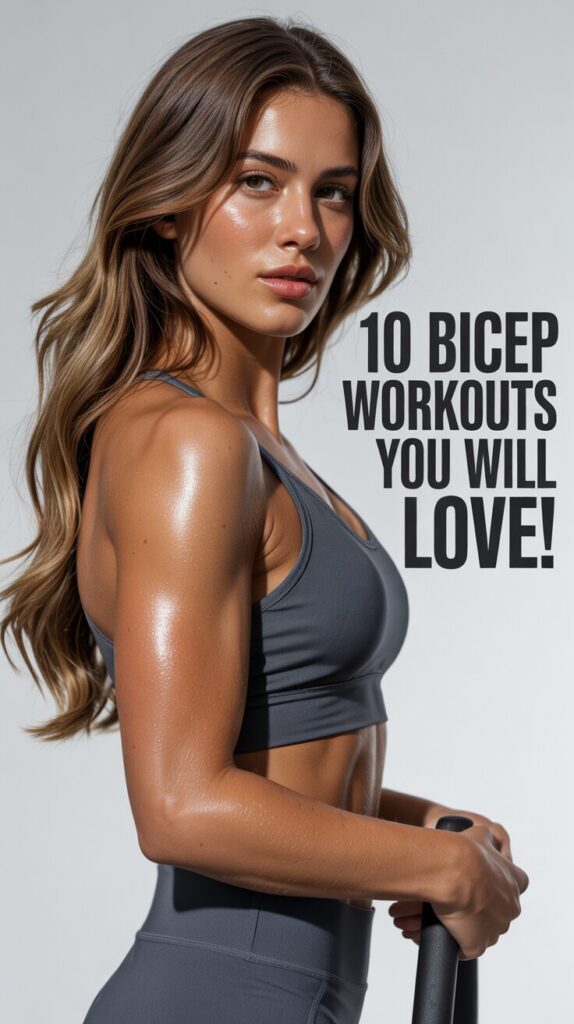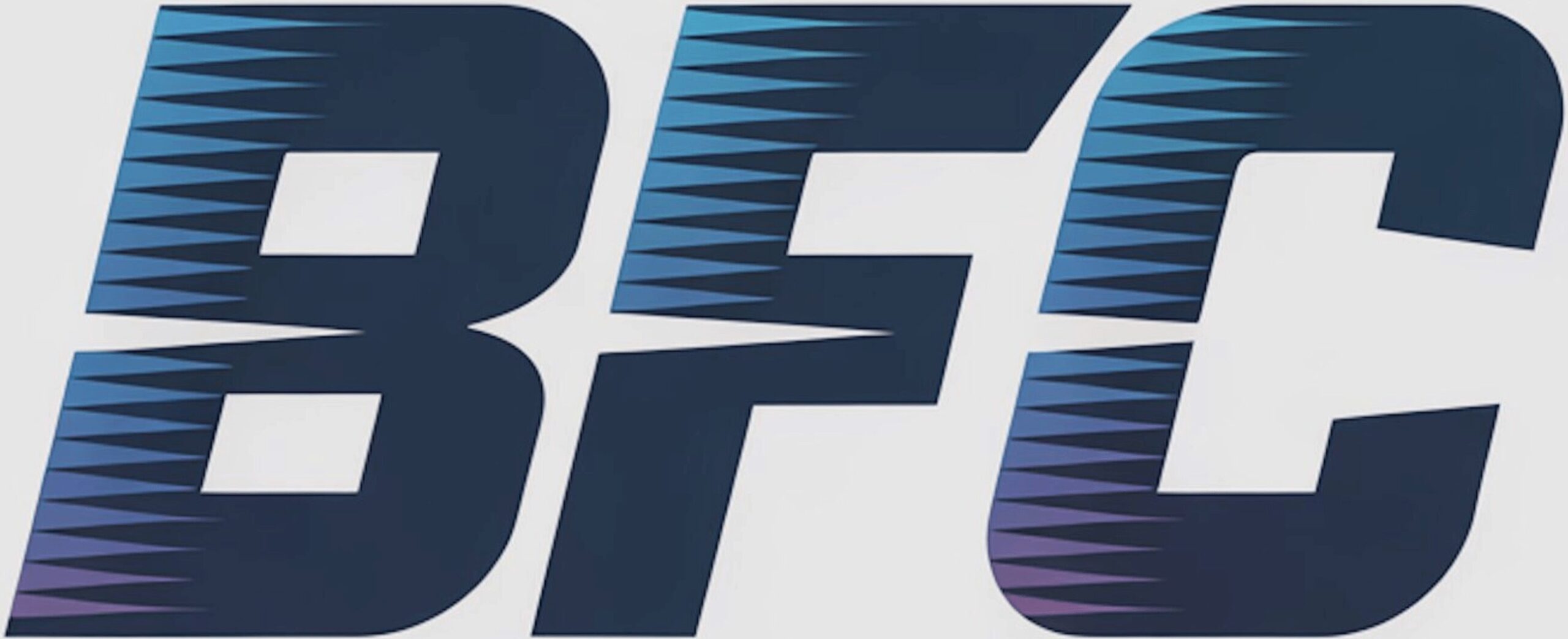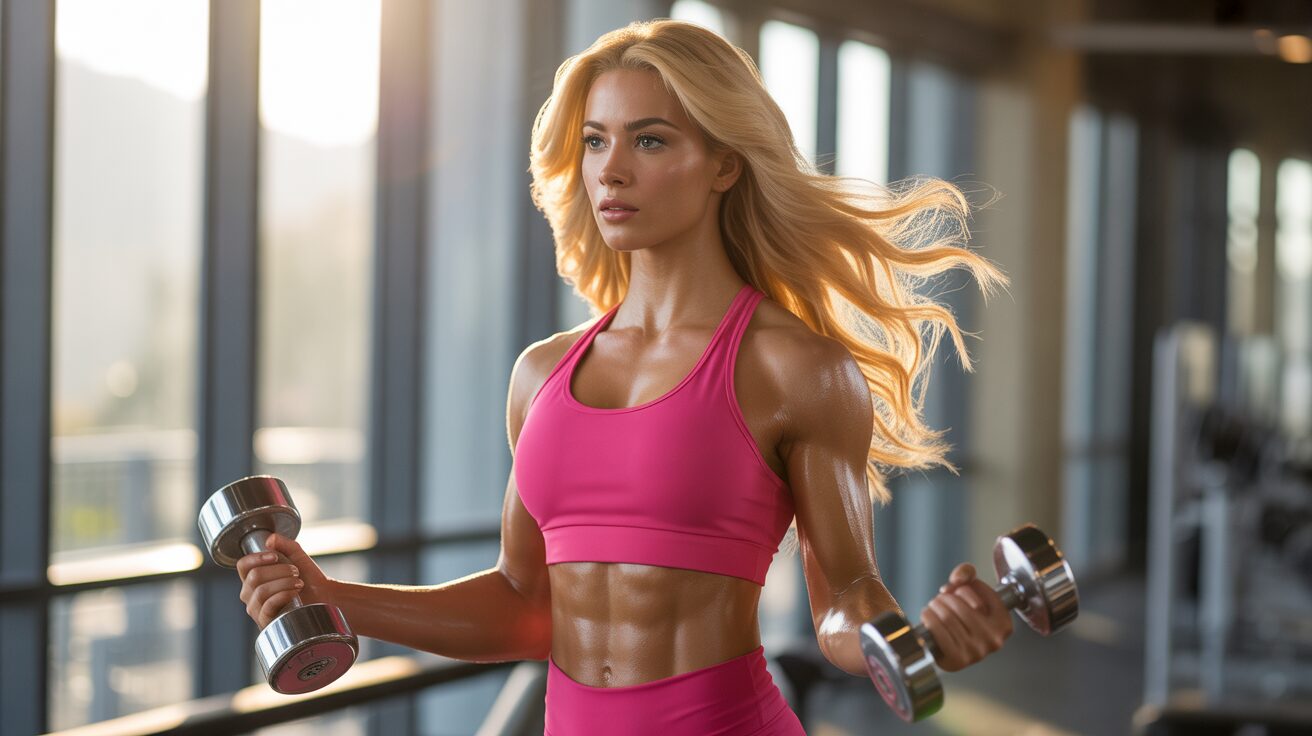You’ll transform your arm training with these proven bicep exercises: classic barbell curls for balanced development, incline dumbbell curls targeting the long head under maximum stretch, and concentration curls emphasizing peak contraction. Add hammer curls to build arm thickness through brachialis activation, chin-ups for functional strength with 107-205% MVC biceps engagement, and cable variations that maintain constant tension throughout each rep. EZ bar curls reduce wrist strain while alternating dumbbell curls correct imbalances between arms. The techniques below reveal how to maximize each movement’s potential.
Key Takeaways
- Classic barbell and EZ bar curls build overall bicep mass while allowing heavy loads with reduced wrist strain.
- Incline dumbbell curls maximize stretch on the long head; concentration curls emphasize peak contraction for complete development.
- Hammer curls and neutral grip cable variations target the brachialis and forearms, adding arm thickness and strength.
- Chin-ups provide functional bicep strength with higher activation than pull-ups, requiring minimal equipment for home training.
- Single-arm high cable curls deliver constant tension, correct strength imbalances, and reduce joint strain compared to barbells.
Classic Barbell Curl for Balanced Bicep Development

The classic barbell curl stands as the cornerstone of bicep training, allowing you to lift heavier weight with both arms simultaneously while maintaining balanced muscle development. Position your barbell grip at shoulder-width, utilizing an EZ curl bar to minimize wrist strain. Establish proper bicep posture by keeping elbows close to your sides, core engaged, and shoulders back with chest up. Incorporating a variety of movements helps keep workouts engaging and supports overall arm strength and tone.
Execute each rep with full control—curl to shoulder height while maintaining slight elbow flexion at the bottom to protect joints. Squeeze the bar tightly to activate forearms, hold the peak contraction for one second, then emphasize the eccentric phase with deliberate tempo. The barbell curl effectively targets both the biceps and brachialis, developing not only the two heads of the biceps but also the underlying muscle that contributes to overall arm width. Avoid momentum-based lifting; instead, focus on sustained tension throughout the movement to maximize hypertrophy and strength gains.
Incline Dumbbell Curl to Target the Long Head
While barbell curls build overall mass, incline dumbbell curls strategically isolate the long head of your biceps by placing the muscle under maximum stretch at the bottom position. Your incline bench setup requires a 30º to 45º angle—higher angles increase stretch intensity. Lock your back against the pad with feet flat on the ground for stability.
Master your elbow positioning by keeping your upper arms stationary and slightly behind your rib cage throughout the movement. Any forward drift recruits your front delts and reduces biceps isolation. Start with pronated hands at the bottom, then supinate as you curl upward in an arcing path. Squeeze hard at the top, then control the eccentric phase. Grip the dumbbells in the middle of the bar rather than at the ends for balanced control and proper form. Maintain 60 seconds of time under tension per set while prioritizing form over weight. Consistency and gradual progression in load are key to achieving lasting muscle growth.
Concentration Curl for Maximum Muscle Activation

After maximizing stretch tension with incline curls, concentration curls take the opposite approach by emphasizing peak contraction at the shortened position. You’ll achieve superior biceps brachii isolation by positioning your upper arm against your inner thigh—not on top, which creates unwanted leverage. This setup eliminates momentum and strengthens your muscle connection through strict elbow-only movement. These at-home variations require minimal equipment and are accessible for all fitness levels home workouts.
Position your arm deeper into the groin area to maintain perpendicular resistance throughout the range. Squeeze hard at the top, then control the eccentric phase deliberately. Among curl variations, this exercise stands out as research-validated for targeting the biceps peak. The deliberate pace reduces injury risk while helping you master proper lifting mechanics.
Program 3 sets of 8–12 reps per arm as a finisher after compound movements. Avoid common mistakes: swinging, elbow placement too high, or letting your arm drift parallel to gravity at contraction—these create junk volume without meaningful tension.
Hammer Curl to Build Arm Thickness
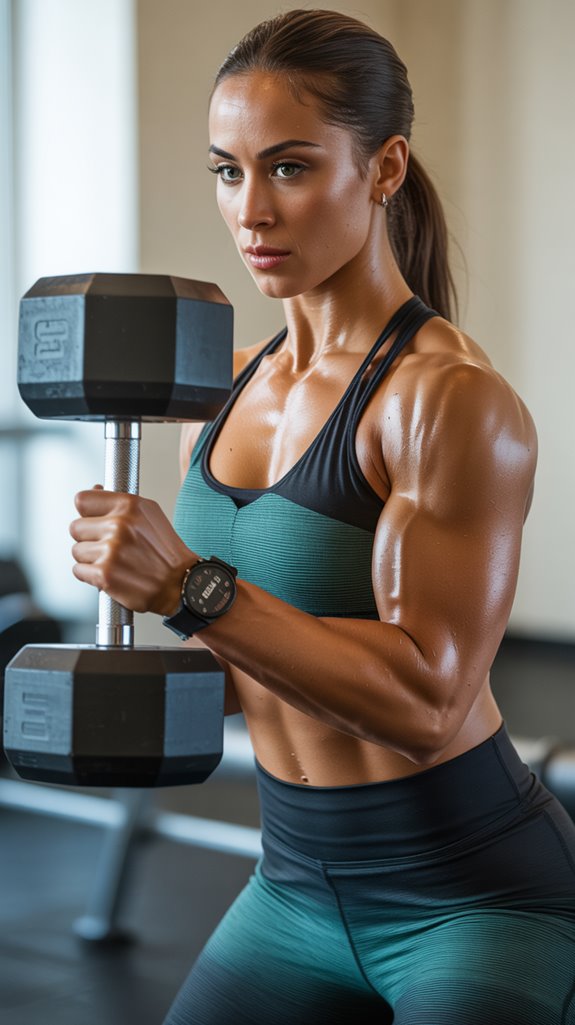
Hammer curls transform your arm development by targeting the often-neglected brachialis muscle that lies beneath your biceps brachii. The neutral grip positioning—palms facing each other—maximizes muscle activation in both the brachialis and forearm extensors, creating that coveted 3D arm appearance. You’ll handle heavier loads than standard curls since your forearms assist throughout the movement.
Execute with precision using these form essentials:
- Position your feet hip-width apart with elbows slightly forward of your hips, maintaining perpendicular upper arms
- Keep thumbs pointing upward throughout the entire range without rotating your palms
- Eliminate momentum by engaging your glutes and core, preventing any waist rocking
- Squeeze your shoulder blades together to minimize swinging and maintain full-body tension
Start with 3 sets of 6-8 reps using challenging weight, progressing to 15-20 reps as strength develops.
Chin-Ups for Functional Bicep Strength

Chin-ups deliver unmatched functional bicep development that isolation exercises simply can’t replicate. You’ll activate your biceps brachii, brachialis, and brachioradialis while simultaneously engaging your lats, rear deltoids, and core for complete upper body strength. Research shows chin-ups generate markedly higher biceps activation than pull-ups—107 to 205 MVC versus 65 to 145.
Master various chin up variations to maximize growth. Narrow grips target the long head, while wider grips emphasize the short head. Neutral grips reduce wrist strain without sacrificing bicep engagement. These grip adjustments let you address weak points and accommodate your anatomy.
Execute full dead-hang reps with controlled tempo, especially during the eccentric phase. Progress by adding weight through dip belts or weighted vests. You can perform chin-ups at home with minimal equipment, such as a doorway bar, making them accessible for any fitness level. You’ll build functional strength that transfers directly to athletic performance and real-world movements.
Preacher Curl for Short Head Isolation

The preacher curl stands as the definitive exercise for isolating your biceps’ short head, which adds thickness and width to your arm’s appearance. By positioning your elbows forward on the pad, you’ll maximize short head activation throughout the movement’s early phase. The preacher curl benefits extend beyond simple isolation—the pad eliminates momentum and cheating, forcing strict form that concentrates tension precisely where you need it.
To optimize your technique:
- Use a narrow grip (inside shoulder width) with an EZ bar or straight barbell to emphasize short head recruitment
- Maintain a slight bend at the bottom position to preserve continuous tension and protect your joints
- Control the eccentric phase deliberately to maximize muscle fiber recruitment and hypertrophic stimulus
This foundational movement delivers consistent, measurable gains in arm fullness. The exercise enhances your mind-muscle connection for improved neuromuscular activation, allowing you to better target and feel the biceps working throughout each repetition.
Cable Rope Hammer Curl for Constant Tension
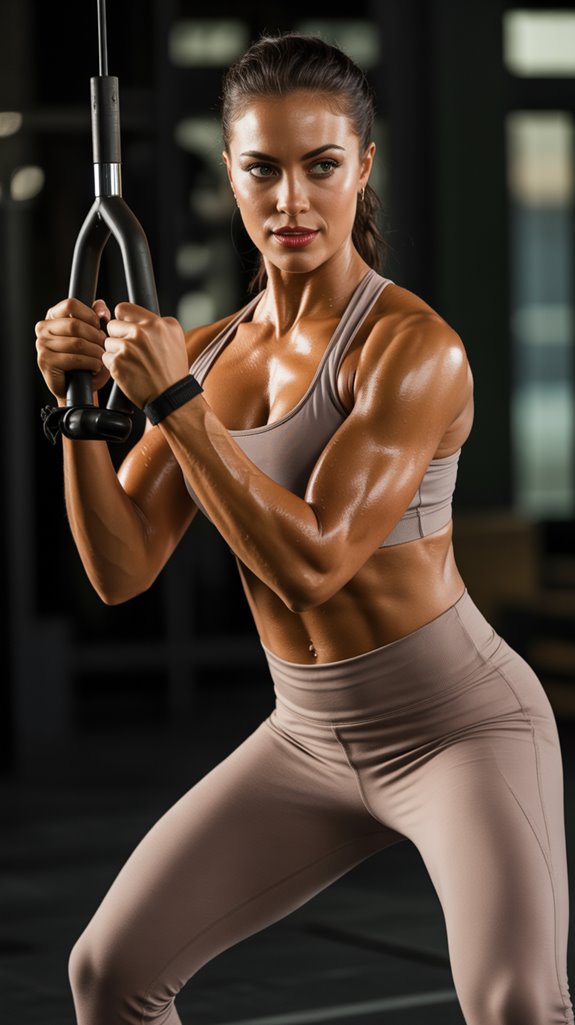
While preacher curls lock you into a fixed position for maximum short head isolation, cable rope hammer curls introduce a different advantage: unrelenting tension that challenges your biceps, brachialis, and forearms from start to finish. The constant resistance from cables guarantees continuous muscle engagement throughout every inch of your range of motion, maximizing time under tension for superior hypertrophy.
The neutral grip position targets your brachioradialis and brachialis while reducing wrist and elbow strain—making this variation ideal if you’re managing joint discomfort. You’ll build balanced arm development and functional grip strength that carries over to deadlifts and pull-ups. Stand with feet hip-width apart and position yourself 10 to 12 inches from the machine for optimal cable tension. Attach a rope handle, keep your elbows tucked, and control both the concentric and eccentric phases. For enhanced peak contraction, twist the rope ends outward at the top.
EZ Bar Curl to Reduce Wrist Strain
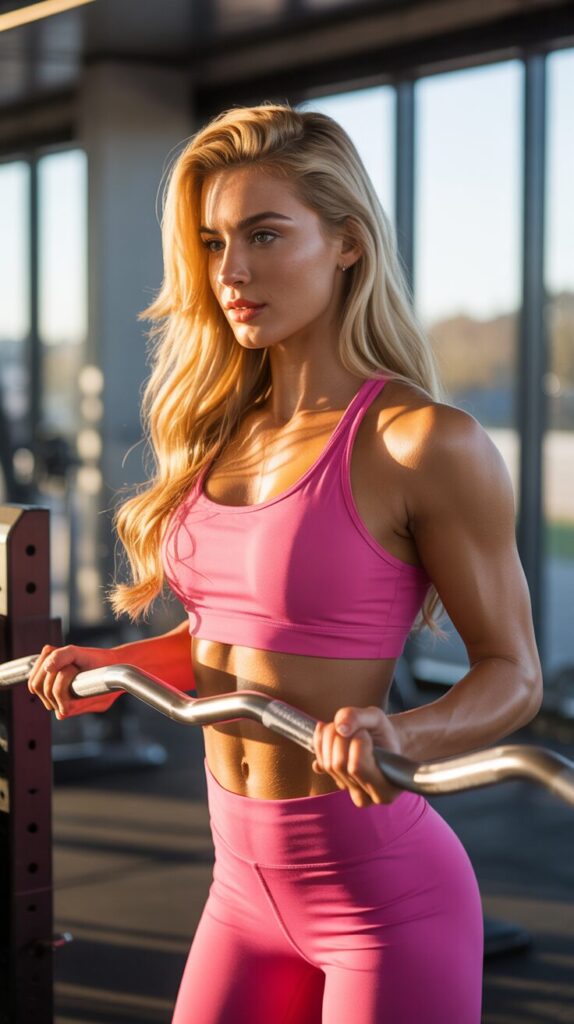
Though straight bars provide slightly higher peak activation, the EZ bar’s balanced stimulus supports sustainable arm growth without compromising your joints. The angled grip design reduces wrist strain, making it more comfortable to handle heavier loads during your bicep training.
Alternating Dumbbell Curl to Correct Imbalances

If you’ve noticed one arm lagging behind the other in size or strength, alternating dumbbell curls deliver the targeted correction you need. This unilateral approach forces each biceps to lift identical loads independently, eliminating compensation from your dominant side and promoting genuine muscle symmetry. You’ll enhance neuromuscular coordination while addressing discrepancies that bilateral movements often mask.
The alternating pattern offers distinct advantages for strength progression. Your nervous system enables slightly heavier loads compared to simultaneous curls, increasing time-under-tension per arm. You’ll develop a superior mind-muscle connection by concentrating on one contraction at a time, minimizing momentum and maximizing fiber recruitment.
Beyond correcting imbalances, you’ll build core stability as each rep demands precise postural control. This bracing transfers directly to compound lifts, making alternating curls essential for thorough development. The exercise trains both the biceps brachii and brachialis, with the brachialis located beneath the biceps contributing significantly to overall arm thickness and flexion strength.
Single-Arm High Cable Curl for Peak Contraction
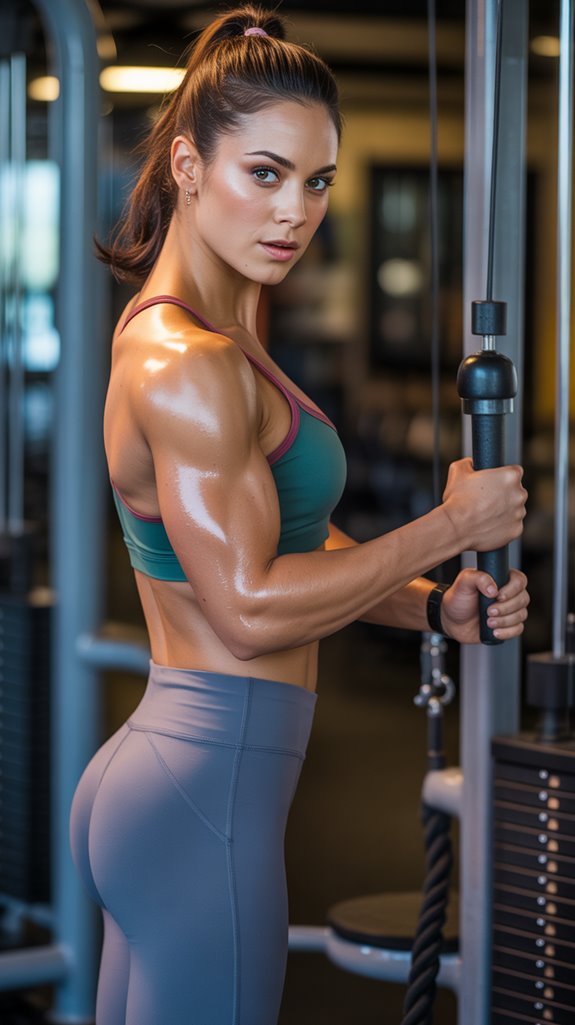
Cable machines introduce a game-changing variable that free weights can’t replicate: constant tension throughout every millimeter of movement. The single-arm high cable curl exploits this principle perfectly. Position yourself facing the machine with the handle set above head height, then curl toward your ear while maintaining an elevated elbow. This angle maximizes biceps muscle mechanics by creating peak contraction at the top position.
Cable machine benefits you’ll experience:
- Enhanced muscle fiber recruitment – The high pulley angle targets both biceps heads simultaneously while emphasizing the short head
- Unilateral focus – Identify and correct strength discrepancies between arms
- Superior mind-muscle connection – Isolate each arm without compensatory momentum
Execute 3-4 sets of 10-15 reps, holding the peak contraction for two seconds before controlling the eccentric phase. This movement places reduced strain on elbows and wrists compared to heavy barbell variations, making it sustainable for long-term training.
Conclusion
You’ve just released the absolute arsenal of bicep destruction that’ll transform those noodle arms into pythons so massive, you’ll need to walk through doorways sideways! These ten exercises aren’t just workouts—they’re weapons of mass construction that’ll have your sleeves begging for mercy within weeks. You’ll build peaks so towering, they’ll cast shadows in broad daylight. Now stop reading and start curling like your life depends on it!
